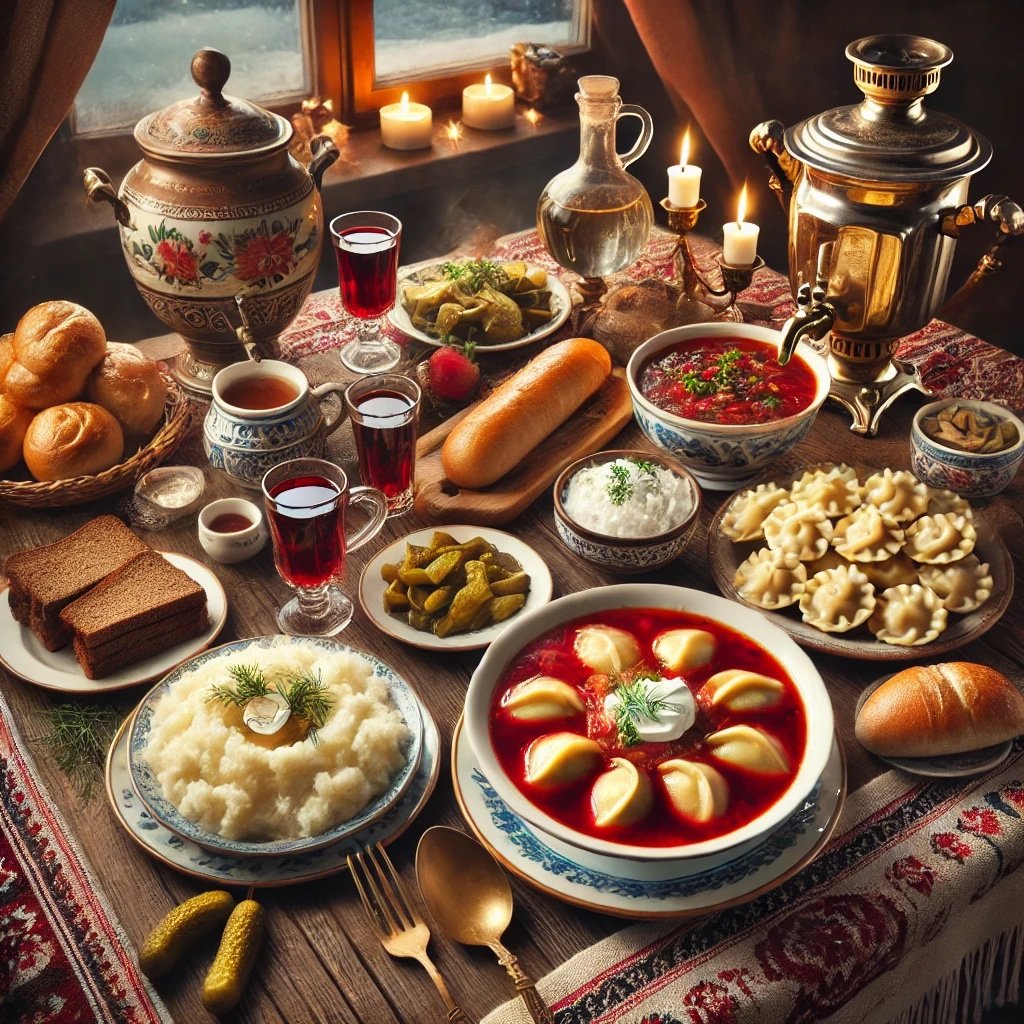How to Host a Traditional Russian Dinner Party
Introduction: The Warmth and Tradition of a Russian Dinner Party
Imagine walking into a cozy home filled with the rich aroma of freshly baked bread, simmering soups, and the unmistakable scent of dill and garlic. Laughter echoes through the room as guests gather around a beautifully set table, raising their glasses for the first toast of the evening. This is the essence of a traditional Russian dinner party—a warm, welcoming celebration of food, culture, and togetherness.
Russian hospitality is legendary, and a dinner party in Russia is not just about eating; it’s about creating an experience. If you’ve ever wanted to host an authentic Russian dinner party, this guide will help you plan every detail—from the perfect menu to essential etiquette and cultural traditions.
At Polyglottist Language Academy, we believe that learning a language is more than just words; it’s about understanding the culture. Whether you’re learning Russian or simply love Russian cuisine, hosting a traditional Russian dinner party is a wonderful way to bring friends and family together.
1. Setting the Scene: The Atmosphere of a Russian Dinner Party
1.1 The Importance of Hospitality
In Russian culture, guests are considered a blessing, and hosts go out of their way to make sure their visitors feel at home. Expect abundant food, heartfelt conversations, and plenty of toasts.
1.2 Traditional Russian Table Setting
A Russian dinner table is often decorated with:
A large tablecloth (often white or embroidered)
Traditional Russian ceramics or Gzhel porcelain
Samovar (a decorative tea urn, often for display)
Small plates for zakuski (appetizers)
Vodka glasses and wine goblets for multiple toasts
1.3 Essential Russian Dining Etiquette
Guests never arrive empty-handed—bring a small gift, like flowers, chocolates, or wine.
The host typically places dishes in the center of the table for everyone to share.
Toasts are a big deal—every round of drinks comes with a speech!
2. The Russian Dinner Party Menu: What to Serve
A Russian dinner party follows a multi-course meal that includes cold appetizers, hearty soups, meat dishes, and plenty of bread.
2.1 Zakuski (Appetizers & Starters)
Before the main course, guests enjoy a variety of small dishes called zakuski. These are served at room temperature and are meant to be enjoyed with drinks.
Essential Zakuski Dishes:
Оливье (Olivier Salad) – A famous potato salad with peas, pickles, and mayonnaise.
Селёдка под шубой (Herring Under a Fur Coat) – A layered salad with herring, beets, potatoes, and mayonnaise.
Икра (Caviar & Blini) – Russian pancakes served with red or black caviar.
Маринованные овощи (Pickled Vegetables) – Cucumbers, tomatoes, garlic, and mushrooms.
2.2 Soup Course: The Heart of Russian Cuisine
No Russian meal is complete without a hearty soup. The most traditional options include:
Борщ (Borscht) – A beet-based soup served with sour cream.
Щи (Shchi) – A cabbage soup, often made with beef.
Солянка (Solyanka) – A thick, sour soup with various meats and pickles.
2.3 Main Course: Rich and Satisfying Dishes
Russian main dishes are often meat-heavy and accompanied by potatoes or grains.
Popular Russian Main Dishes:
Пельмени (Pelmeni) – Russian dumplings filled with meat, served with sour cream.
Голубцы (Goluptsi) – Cabbage rolls stuffed with ground meat and rice.
Курица по-купечески (Merchant’s Chicken) – Chicken baked with cheese, mushrooms, and potatoes.
2.4 Side Dishes and Bread
Russian meals are served with fresh or rye bread and side dishes such as:
Гречка (Grechka) – Buckwheat, a staple in Russian households.
Картофельное пюре (Kartofel’noe Pyure) – Creamy mashed potatoes.
2.5 Desserts: A Sweet Ending
Russian desserts are often simple but delicious:
Медовик (Medovik) – Honey cake with layers of cream.
Пирожки (Pirozhki) – Small pastries filled with fruit or meat.
Варенье (Varenye) – Russian jam, often served with tea.
3. Drinks: Vodka, Kvass, and Tea
3.1 Vodka and Traditional Russian Toasts
Vodka is the drink of choice at a Russian dinner party. Each shot is accompanied by a toast (тост, tost). The first toast is always “За здоровье!” (“To health!”)
3.2 Kvass: The Non-Alcoholic Alternative
Kvass is a fermented bread drink that is slightly sweet and tangy—a perfect alternative for those who don’t drink alcohol.
3.3 Tea Culture: Ending the Evening with Chai
A Russian meal traditionally ends with black tea served in small glasses. It’s often paired with jam, honey, or sweets.
4. Entertainment: Keeping Guests Engaged
A Russian dinner party is not just about food—it’s also about fun!
4.1 Singing and Folk Music
Russians love to sing, especially after a few toasts. If you have a guitar, learn a few traditional Russian folk songs to impress your guests.
4.2 Classic Russian Party Games
Горячая картошка (Hot Potato) – A simple game played with a small item passed around.
Испорченный телефон (Broken Telephone) – Similar to the game of “Chinese Whispers.”
4.3 Storytelling and Jokes
Russians appreciate humor and storytelling. Encourage guests to share funny stories or personal anecdotes.
Conclusion: Bringing Russian Culture to Your Home
Hosting a traditional Russian dinner party is a wonderful way to experience the warmth and hospitality of Russian culture. With a thoughtfully prepared menu, engaging entertainment, and a welcoming atmosphere, your guests will leave with full hearts and satisfied stomachs.
If you want to deepen your understanding of Russian language and culture, check out our Russian Online Classes at Polyglottist Language Academy.
More Russian Culture & Language Articles:
Mastering Russian Cases: A Beginner’s Guide
The Russian Verb System: Perfective vs. Imperfective
Common Russian Proverbs and Their Meanings
Understanding Russian Sentence Structure
How to Sound Natural in Russian: Essential Tips
Ready to explore more? Join our Russian Online Classes today!

